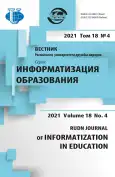Tренды образовательных технологий в России и мире в 2020 г.: анализ поисковых запросов в Google Trends
- Авторы: Осиповская Е.А.1
-
Учреждения:
- Онлайн-университет Skillbox
- Выпуск: Том 18, № 4 (2021)
- Страницы: 291-304
- Раздел: ГЛОБАЛЬНЫЕ АСПЕКТЫ ИНФОРМАТИЗАЦИИ ОБРАЗОВАНИЯ
- URL: https://journal-vniispk.ru/2312-8631/article/view/321218
- DOI: https://doi.org/10.22363/2312-8631-2021-18-4-291-304
- ID: 321218
Цитировать
Полный текст
Аннотация
Проблема и цель. Рассматриваются ключевые тенденции, которые стали доминировать в 2020 г. в период пандемии в сфере образования. Изучались результаты исследований Gartner - консалтинговой компании, специализирующейся на рынках информационных технологий, Организации экономического сотрудничества и развития, научно-исследовательского университета Великобритании The Open University, глобального обзора настроений в сфере обучения и развития L&D Global Sentiment Survey и HolonIQ - компании, специализирующейся на аналитике образовательного рынка. Методология. Данные указанных отчетов были объединены и сгруппированы, а затем проанализированы в Google Trends на предмет популярных поисковых запросов в России и мире. Выборка данных производилась за 2020 г. в Google Trends в разделе «Работа и образование». Результаты. Выделены четыре доминантных направления: 1) отрасли; 2) форматы; 3) инструменты; 4) аналитика. Анализировались первые две категории. В рамках форматов на примерах рассмотрены технологии, применяемые в массовых открытых онлайн-курсах, гибридном, смешанном обучении, персонализации, перевернутом классе, инклюзии и при использовании симуляторов. В рамках «инструментов» - мобильные технологии, социальные сети, смешанная и дополненная реальность (AR/VR), виртуальные классы, искусственный интеллект (AI), система управления обучением (LMS). Заключение. Самым популярным поисковым запросом среди российских пользователей и мировой аудитории в целом в группе «форматы» стали вопросы реализации инклюзивной практики в условиях пандемии COVID-19. В категории «инструменты» у пользователей также сложился консенсус: больше всего их в 2020 г. интересовали характеристики и виды LMS-платформ для более эффективного осуществления онлайн-обучения.
Об авторах
Елизавета Андреевна Осиповская
Онлайн-университет Skillbox
Автор, ответственный за переписку.
Email: e.osipovskaya@gmail.com
кандидат филологических наук, лектор
Российская Федерация, 121205, Москва, Ленинский пр-кт, д. 6, стр. 20Список литературы
- Malofeev NN. Inclusive education in the context of modern social policy. Education and Training of Children with Developmental Disabilities. 2009;(6):3-9. (In Russ.)
- Hegarty S. Reviewing the literature on integration. European Journal of Special Needs Education. 1993;8(3):190-200. https://doi.org/10.1080/0885625930080302
- Freeman S, Alkin M. Academic and social attainments of children with mental retardation in general education and special education settings. Remedial and Special Education. 2000;21(1):3-26. https://doi.org/110.1177/074193250002100102
- Zigmond N. Where should students with disabilities receive special education services? Is one place better than another? Journal of Special Education. 2003;37(3):193-199. https://doi.org/110.1177/00224669030370030901
- Lindsay G. Educational psychology and the effectiveness of inclusive education/ mainstreaming. British Journal of Educational Psychology. 2007;77(1):1-24. https://doi.org/110.1348/000709906X156881
- Szumski G, Smogorzewska J, Karwowski M. Academic achievement of students without special educational needs in inclusive classrooms: a meta-analysis. Educational Research Review. 2017;21:33-54. https://doi.org/10.1016/j.edurev.2017.02.004
- Block ME, Obrusnikova I. Inclusion in physical education: a review of the literature from 1995-2005. Adapted Physical Activity Quarterly. 2007;24(2):103-124. https://doi.org/10.1123/apaq.24.2.103
- Scott BJ, Vitale MR, Masten WG. Implementing instructional adaptations for students with disabilities in inclusive classrooms: a literature review. Remedial and Special Education. 1998;19(2):106-119. https://doi.org/10.1177/074193259801900205
- Harrower J, Dunlap G. Including children with autism in general education classrooms: a review of effective strategies. Behavior Modification. 2001;25(5):762-784. https://doi.org/10.1177/0145445501255006
- Nakken H, Pijl SJ. Getting along with classmates in regular schools: a review of the effects of integration on the development of social relationships. International Journal of Inclusive Education. 2002;6(1):47-61. https://doi.org/10.1080/13603110110051386
- Bossaert GH, Colpin SJ, Pilj K, Petry K. Truly included? A literature study focusing on the social dimension of inclusion in education. International Journal of Inclusive Education. 2011;17(1):66-99.
- Osipovskaya E, Dmitrieva S, Grinshkun V. Examining technology and teaching gaps in Russian universities amid coronavirus outbreak. In: Auer ME, Rüütmann T. (eds.) Educating Engineers for Future Industrial Revolutions. ICL 2020. Advances in Intelligent Systems and Computing (vol. 1328). Cham: Springer; 2021. p. 764-774. https://doi.org/10.1007/978-3-030-68198-2_72
- Graham CR. Blended learning systems: definition, current trends, and future directions. In: Bonk CJ, Graham CR. (eds.) Handbook of Blended Learning: Global Perspectives, Local Designs. San Francisco: Pfeiffer Publishing; 2006.
- Grinshkun V, Osipovskaya E. Teaching in the fourth industrial revolution: transition to education 4.0. CEUR Workshop Proceedings. 2020;2770:9-15.
- Skornyakova ER, Pinegina AA. Self-organization of students of non-linguistic specialties as a factor in the formation of a graduate of a new formation. Pedagogy. Questions of Theory and Practice. 2021;(6):1087-1095. https://doi.org/10.30853/ped20210133
Дополнительные файлы









